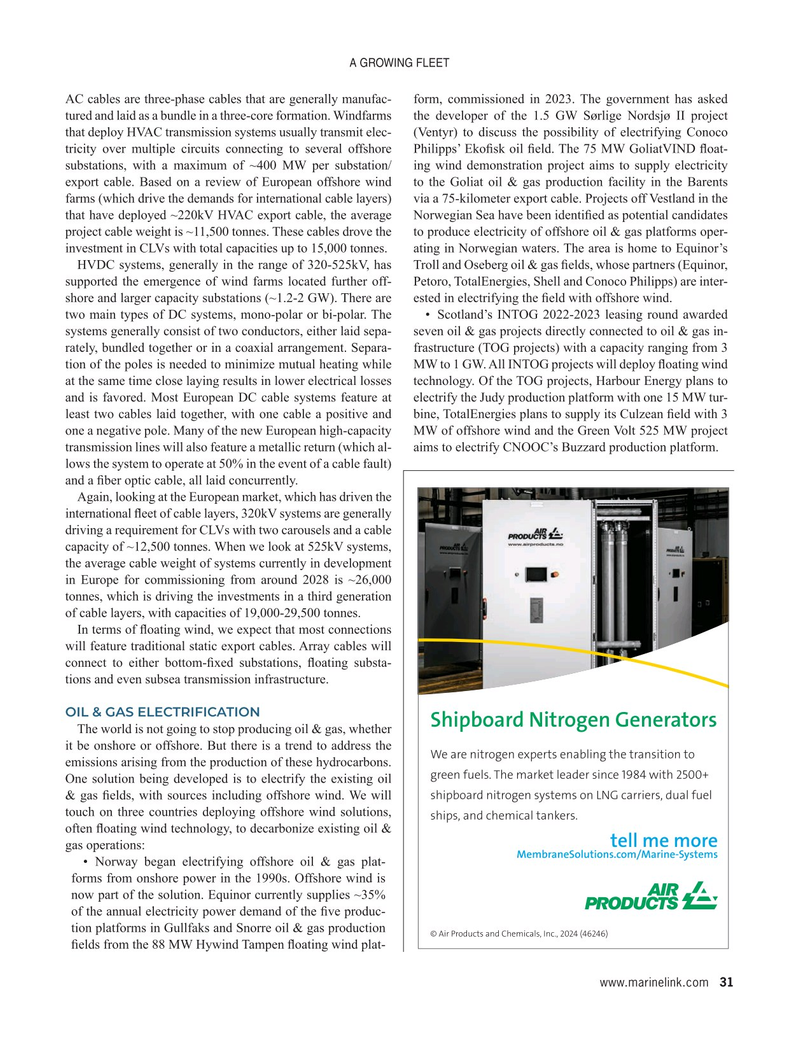
Page 31: of Maritime Reporter Magazine (August 2024)
Read this page in Pdf, Flash or Html5 edition of August 2024 Maritime Reporter Magazine
A GROWING FLEET
AC cables are three-phase cables that are generally manufac- form, commissioned in 2023. The government has asked tured and laid as a bundle in a three-core formation. Windfarms the developer of the 1.5 GW Sørlige Nordsjø II project that deploy HVAC transmission systems usually transmit elec- (Ventyr) to discuss the possibility of electrifying Conoco tricity over multiple circuits connecting to several offshore Philipps’ Eko? sk oil ? eld. The 75 MW GoliatVIND ? oat- substations, with a maximum of ~400 MW per substation/ ing wind demonstration project aims to supply electricity export cable. Based on a review of European offshore wind to the Goliat oil & gas production facility in the Barents farms (which drive the demands for international cable layers) via a 75-kilometer export cable. Projects off Vestland in the that have deployed ~220kV HVAC export cable, the average Norwegian Sea have been identi? ed as potential candidates project cable weight is ~11,500 tonnes. These cables drove the to produce electricity of offshore oil & gas platforms oper- investment in CLVs with total capacities up to 15,000 tonnes. ating in Norwegian waters. The area is home to Equinor’s
HVDC systems, generally in the range of 320-525kV, has Troll and Oseberg oil & gas ? elds, whose partners (Equinor, supported the emergence of wind farms located further off- Petoro, TotalEnergies, Shell and Conoco Philipps) are inter- shore and larger capacity substations (~1.2-2 GW). There are ested in electrifying the ? eld with offshore wind.
two main types of DC systems, mono-polar or bi-polar. The • Scotland’s INTOG 2022-2023 leasing round awarded systems generally consist of two conductors, either laid sepa- seven oil & gas projects directly connected to oil & gas in- rately, bundled together or in a coaxial arrangement. Separa- frastructure (TOG projects) with a capacity ranging from 3 tion of the poles is needed to minimize mutual heating while MW to 1 GW. All INTOG projects will deploy ? oating wind at the same time close laying results in lower electrical losses technology. Of the TOG projects, Harbour Energy plans to and is favored. Most European DC cable systems feature at electrify the Judy production platform with one 15 MW tur- least two cables laid together, with one cable a positive and bine, TotalEnergies plans to supply its Culzean ? eld with 3 one a negative pole. Many of the new European high-capacity MW of offshore wind and the Green Volt 525 MW project transmission lines will also feature a metallic return (which al- aims to electrify CNOOC’s Buzzard production platform.
lows the system to operate at 50% in the event of a cable fault) and a ? ber optic cable, all laid concurrently.
Again, looking at the European market, which has driven the international ? eet of cable layers, 320kV systems are generally driving a requirement for CLVs with two carousels and a cable capacity of ~12,500 tonnes. When we look at 525kV systems, the average cable weight of systems currently in development in Europe for commissioning from around 2028 is ~26,000 tonnes, which is driving the investments in a third generation of cable layers, with capacities of 19,000-29,500 tonnes.
In terms of ? oating wind, we expect that most connections will feature traditional static export cables. Array cables will connect to either bottom-? xed substations, ? oating substa- tions and even subsea transmission infrastructure.
OIL & GAS ELECTRIFICATION
Shipboard Nitrogen Generators
The world is not going to stop producing oil & gas, whether it be onshore or offshore. But there is a trend to address the
We are nitrogen experts enabling the transition to emissions arising from the production of these hydrocarbons. green fuels. The market leader since 1984 with 2500+
One solution being developed is to electrify the existing oil shipboard nitrogen systems on LNG carriers, dual fuel & gas ? elds, with sources including offshore wind. We will touch on three countries deploying offshore wind solutions, ships, and chemical tankers. often ? oating wind technology, to decarbonize existing oil & tell me more gas operations:
MembraneSolutions.com/Marine-Systems • Norway began electrifying offshore oil & gas plat- forms from onshore power in the 1990s. Offshore wind is now part of the solution. Equinor currently supplies ~35% of the annual electricity power demand of the ? ve produc- tion platforms in Gullfaks and Snorre oil & gas production © Air Products and Chemicals, Inc., 2024 (46246) ? elds from the 88 MW Hywind Tampen ? oating wind plat- www.marinelink.com 31
MR #8 (18-33).indd 31 8/8/2024 1:49:16 PM

 30
30

 32
32
